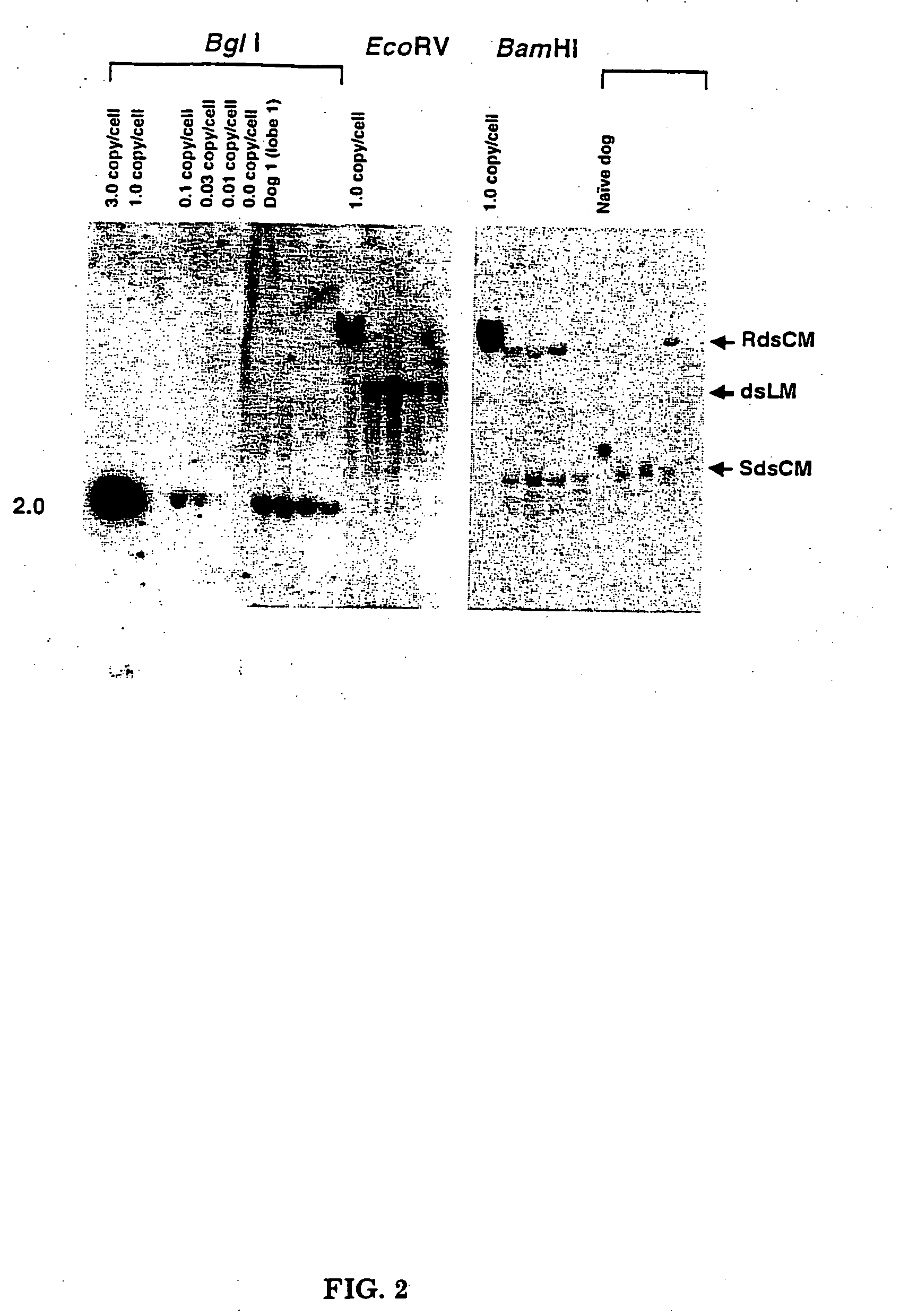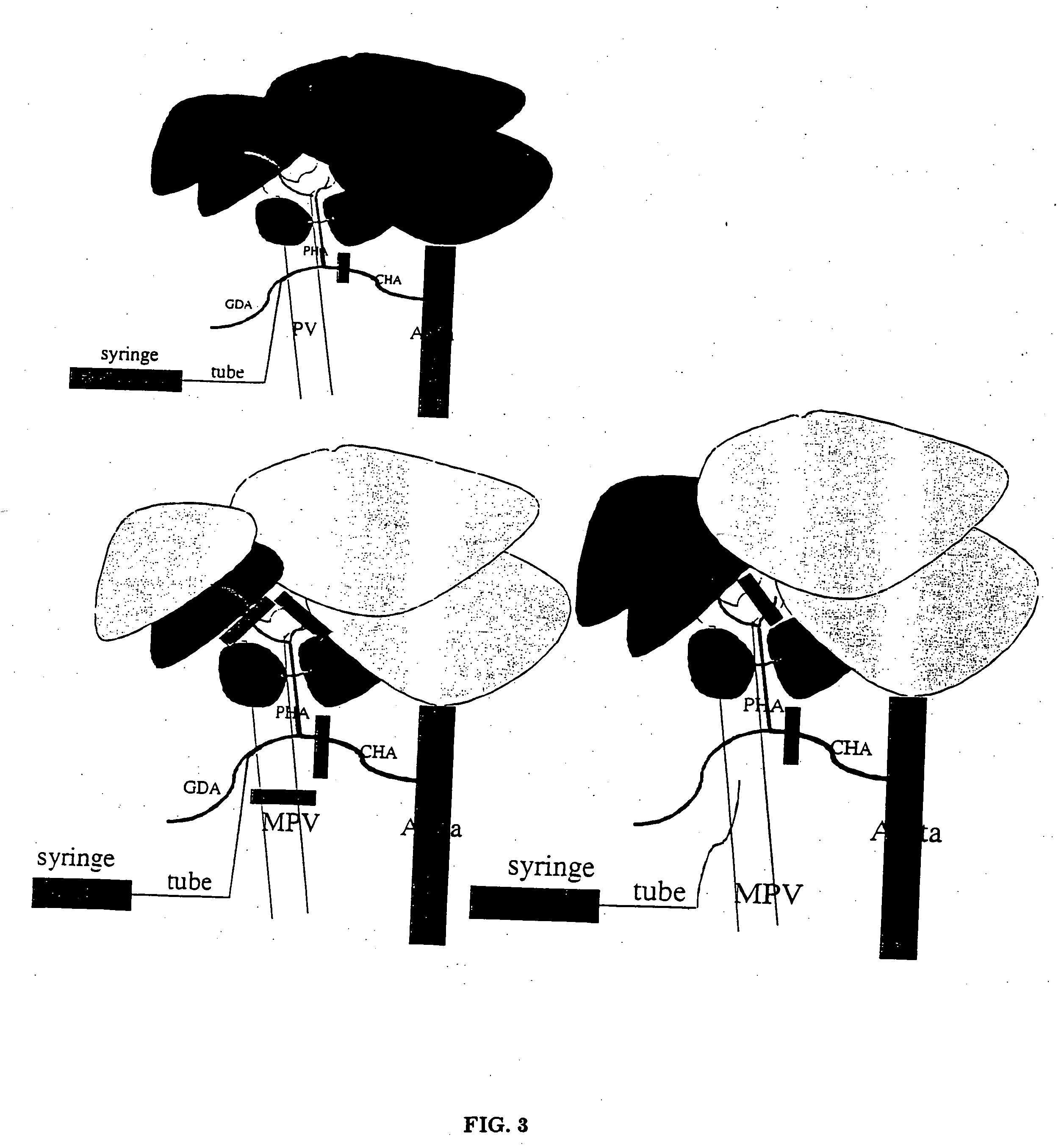Methods for delivering recombinant adeno-associated virus virions to the liver of a mammal
a technology of raav and liver, which is applied in the direction of animal repellents, biocide, genetic material ingredients, etc., can solve the problems of high invasiveness, inability to warrant applications, and increased risk of eliciting unwanted side effects,
- Summary
- Abstract
- Description
- Claims
- Application Information
AI Technical Summary
Benefits of technology
Problems solved by technology
Method used
Image
Examples
example 1
Hepatic Artery Infusion in Dogs
[0053] Three sexually mature male dogs were infused with rAAV-null vector via the hepatic artery at three separate doses: 3.7×1012, 5.0×1012, and 7.0×1012 vg / kg. The hepatic artery perfusions were performed under fluoroscopy with general anesthesia. After sedation, the hepatic artery catheter was inserted in the femoral artery through to the aorta and then fed into the hepatic artery (see FIG. 1). The catheter has a single infusion point and a balloon proximal to the injection site. The balloon was inflated and the vector infused in ˜10 mL of the excipient over a three minute period. The catheter was washed with normal saline and left in place for another seven minutes at which time the balloon was deflated and the catheter removed. To identify gene transfer to the liver, DNA was extracted from all three dogs and subjected to Southern blot analysis. One dog had DNA extracted from four different liver lobes. Twenty μg of total DNA was digested with Bgl...
example 2
Selective Lobe Infusion of Rat Livers
[0054] Rats (Lewis, weight 240 g) were infused with an injection into the left liver lobes using a portal vein approach (see FIG. 3). A laparotomy was performed with the aid of an operating microscope; the common hepatic artery (CHA), main portal vein (MPV), left portal-vein (LPV), and right portal vein (RPV) were isolated from the surrounding tissues. After placing temporary clamps on the CHA and RPV together with the right hepatic artery (RHA), ink solution was injected by puncture of the MPV using a 30 gauge needle for 1 min. After finishing the injection, the needle was pulled out of the MPV. The other clamps were removed 5 minutes later. Only the left liver lobes (30% of the total liver mass) were stained black (see FIG. 4).
[0055] In a second set of infusions, the selected caudate lobes of the liver were infused by hepatic artery injection (see FIG. 3). A laparotomy was performed with the aid of an operating microscope, the CHA, hepatic ar...
example 3
Asanguineous Hepatic Perfusion in Sheep (Ewes)
[0056] The right internal jugular vein is identified with portable ultrasonography. Seldinger technique catheterization of the vein is followed by insertion of a 0.035″ guidewire directed into the suprahepatic vena cava (superior to the right hepatic vein) under fluoroscopy and confirmed by hand-held angiography. A 12 Fr. Dilator is delivered into the jugular vein allowing the ultrasound cannula to be advanced through the sheath introducer and into the right hepatic vein. Following identification of a right portal vein target by duplex imaging, the trans-hepatic needle is loaded over a 0.018″ guide wire into the ultrasound cannula and advanced across the liver parenchyma and into the portal vein. If the portal vein has been accessed, a stiff 0.018″ guide wire is passed through the trans-hepatic needle and into the portal vein and the tract is dilated. The portal vein catheter is then delivered into the main portal vein. Blood shunting f...
PUM
| Property | Measurement | Unit |
|---|---|---|
| Volume | aaaaa | aaaaa |
| Fraction | aaaaa | aaaaa |
| Time | aaaaa | aaaaa |
Abstract
Description
Claims
Application Information
 Login to View More
Login to View More - R&D
- Intellectual Property
- Life Sciences
- Materials
- Tech Scout
- Unparalleled Data Quality
- Higher Quality Content
- 60% Fewer Hallucinations
Browse by: Latest US Patents, China's latest patents, Technical Efficacy Thesaurus, Application Domain, Technology Topic, Popular Technical Reports.
© 2025 PatSnap. All rights reserved.Legal|Privacy policy|Modern Slavery Act Transparency Statement|Sitemap|About US| Contact US: help@patsnap.com



